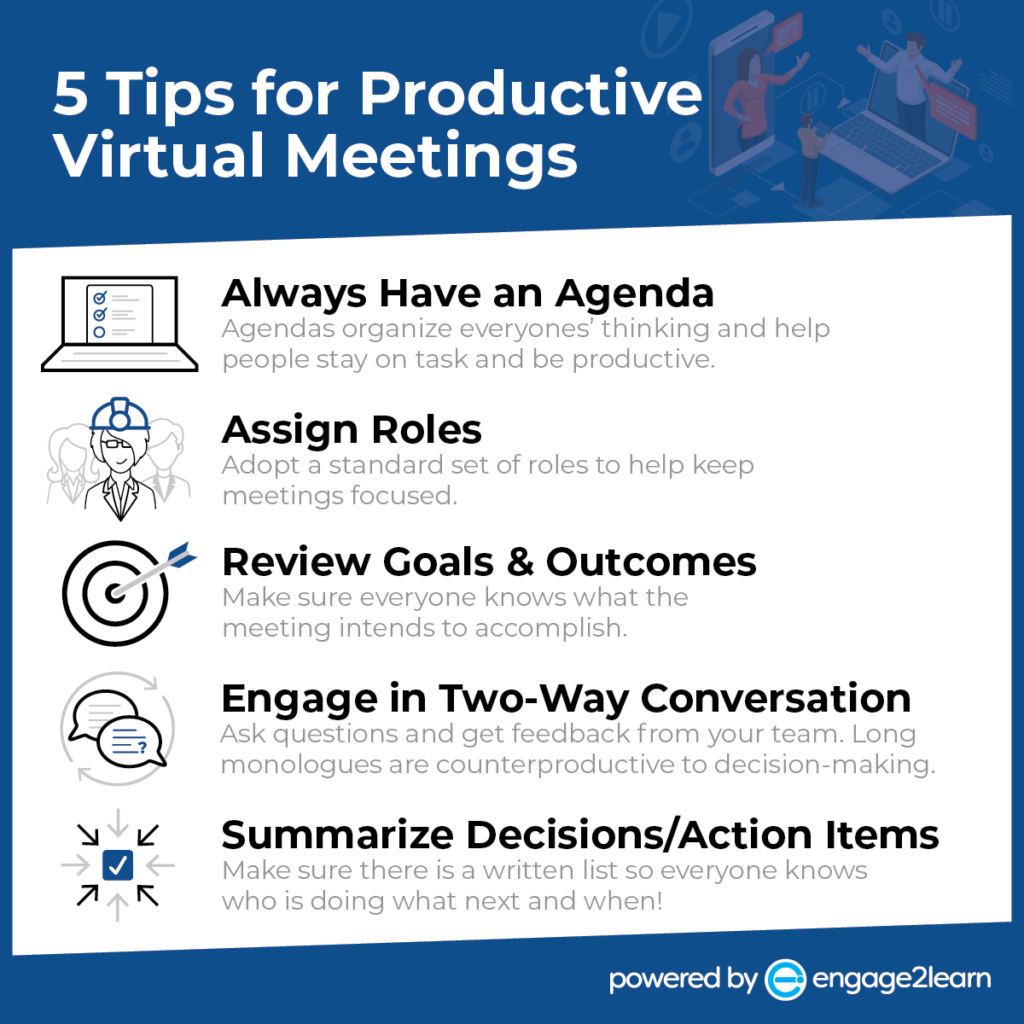5 Quick Tips for Virtual Meetings That Work
This is the second blog of a two-part series on virtual meetings. If you do not already have an effective video-conferencing, project management, and shared calendaring system for your organization, I recommend you go back and read part one first: How to Set Up a Virtual Meeting System and Protocols. This blog also shares how to set up a virtual meeting space at home that limits distractions.
Once you have your virtual meeting system set, it is important to ensure the time spent during the meeting is productive and actionable. In other words, do the decisions made during the meeting get carried out effectively, or do you need another meeting and another meeting on the same topic to get to action? We have honed our processes over the last nine years and have found there are five simple things that can really make a difference. We have proven (as a 100% virtual company) that with the right protocols, virtual meetings are the best of all worlds because you then have uninterrupted time to do the work that results from the meeting!
Recently, after two meetings, one of our partner district superintendents asked if we would share our meeting tools and protocols, commenting, “I feel like your team gets things done at 10X the pace we do in our district even though we have great vision and ideas.” I think our virtual meeting system and protocols have a lot to do with the fast pace at which we work!
What we don’t want to happen…
How often have you had a meeting on a topic only to realize that you had already met on this topic previously yet no decisions had been implemented? If this scenario applies to in-person meetings, imagine how that will be exponentially multiplied virtually unless there are some clear protocols put in place that are proven to work.
Consider this: The average meeting for a central office of a school district costs $720.00 per hour. So, the first question is, do you need a meeting? The answer is probably “yes” if:
- The information is more than one way.
- There are decisions that need to be made collaboratively.
- Actions need to be taken by multiple people in the meeting.
5 Tips for Making Virtual Meetings Productive
Regardless of your meeting context, here are 5 tips that we have found helpful to ensure we have super-focused meetings where we accomplish our shared goals.
1: Do not schedule a meeting with a blank or open agenda.
The type and content of the agenda is the secret sauce to ensuring meetings are actionable. Here is our agenda template. You can make a copy by clicking on the link and then adjusting anything you want. Here are the things that should be included:
- Roles established in the first 30 seconds of the meeting.
- Goals established in the first 3 minutes of the meeting.
- Defined tasks with times on the agenda to ensure the meeting is necessary and has the right amount of time allotted.
- Respect people’s time and workload:
- Always start on time regardless if everyone has joined or not. Do not waste time waiting for people to figure out how to join. Send out these directions in advance.
- Always end on time. If you have a lot left to do, make the call with five minutes left to schedule a second meeting.
2: Establish roles within the first 30 seconds of the meeting.
Have people sign up for roles while everyone is joining by typing their name in the spot next to the role at the top of the agenda. Adopt a standard set of roles including:
- Facilitator: Verbally leads the meeting, helps ensure the agenda items are covered, and keeps people on task
- 1-2 Notetakers: Stay vigilant throughout the meeting to ensure all ideas are captured in the agenda in detail
- Task-master: Listens for and records action items throughout the meeting in the action plan at the bottom including task, person assigned, and due date; transfers tasks to the project management system (see tip 5) during and after the meeting
- Time-keeper: Puts a 2-minute warning in the chat for each section of the agenda to let everyone know the time for that task is almost up; adjusts time when necessary; calls time to review action items 5 minutes before meeting ends or suggests setting another meeting
- Communicator: Listens for and records decisions in Decision box and communications in Communications column; confirms with the team during action item review
Rotating roles is one way to continue to grow people in the organization!
3: Establish goals within the first 3 minutes of the meeting.
Start the meeting by determining the specific, tangible expectations for what is going to be accomplished in the meeting together with all of the attendees. Do not start solving the problems until all of the goals for the meeting are established. If it is a large group, you can prepare the outcomes in advance and get agreement from the team. Depending on the length of the meeting, usually 3 goals are plenty.
Adjust the agenda if the agenda tasks do not match the goals. The role of the facilitator includes going back to the goals throughout the meeting to make sure the team is accomplishing the outcomes, and to check them at the end. If you haven’t completed them, schedule a second meeting.
4: Engage people in the conversation in the following ways:
- Ask questions and provide a place for everyone to add written responses.
- Provide options and have people initial next to the one they want to select.
- Take turns hearing from each person in the meeting on a topic.
- Set up separate hangouts for teams of 3, have them confer, and then rejoin the meeting to share their ideas.
5: Summarize decisions & confirm the action items that will be transferred into the project management system.
Leave at least 5 minutes at the end of the meeting to review the action items (AIs). You will find that when you do that, invariably, something critical was missed. If you are not leaving the meeting with action items in place, why did you take the time to meet in the first place? You just wasted time talking to each other unless you assign AIs and provide everyone clarity on next steps.
To ensure that the time is truly productive, it is not good enough for people to make a to-do list on the bottom of the agenda and call it good. Truly actionable meetings end with action items recorded in a task management or project management system with persons assigned and due dates set for each task. If it is a project meeting, the next meeting can begin with a review of the AIs assigned. Here are a few project management platforms to consider for your organization: Wrike, Asana, Scoro, BASECAMP, and Proofhub.
RELATED: How to Set Up a Virtual Meeting System and Protocols
Converting all that wasted time into productive time that moves your mission forward is one of the keys to a culture of engagement and ownership within an organization. A culture of high performance is not an accident. People are motivated by protocols that honor who they are and what they can contribute. Imagine looking forward to meetings because you know something exciting and interesting is going to happen. We do!
Quick Turnaround
A way to turn this around quickly and start using these ideas tomorrow is to click the link for the agenda template, which will make a copy for you. Rename the document and tweak any of the norms, roles, branding, or content to become your master agenda template. You can turn the template into a Google template in the Docs gallery OR on your choice of a shared server. Share it with your leadership team and start using the agenda in the next meeting. And, remember, we are just an email, phone call, or text away if you need clarification or assistance during this time of transition!
P.S. You can keep using this agenda and these protocols once you start having in-person meetings again. You will be delighted with how much time you save!




